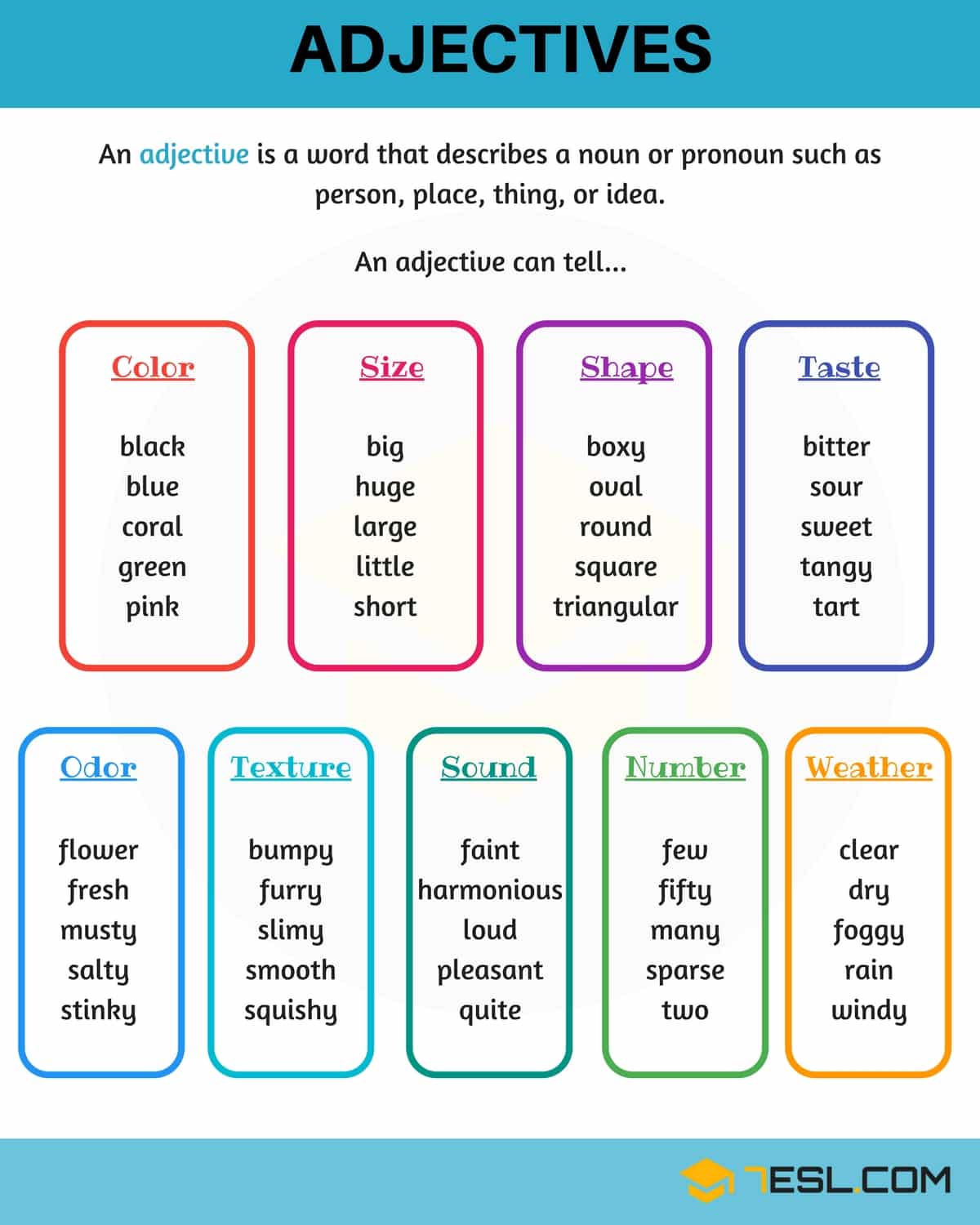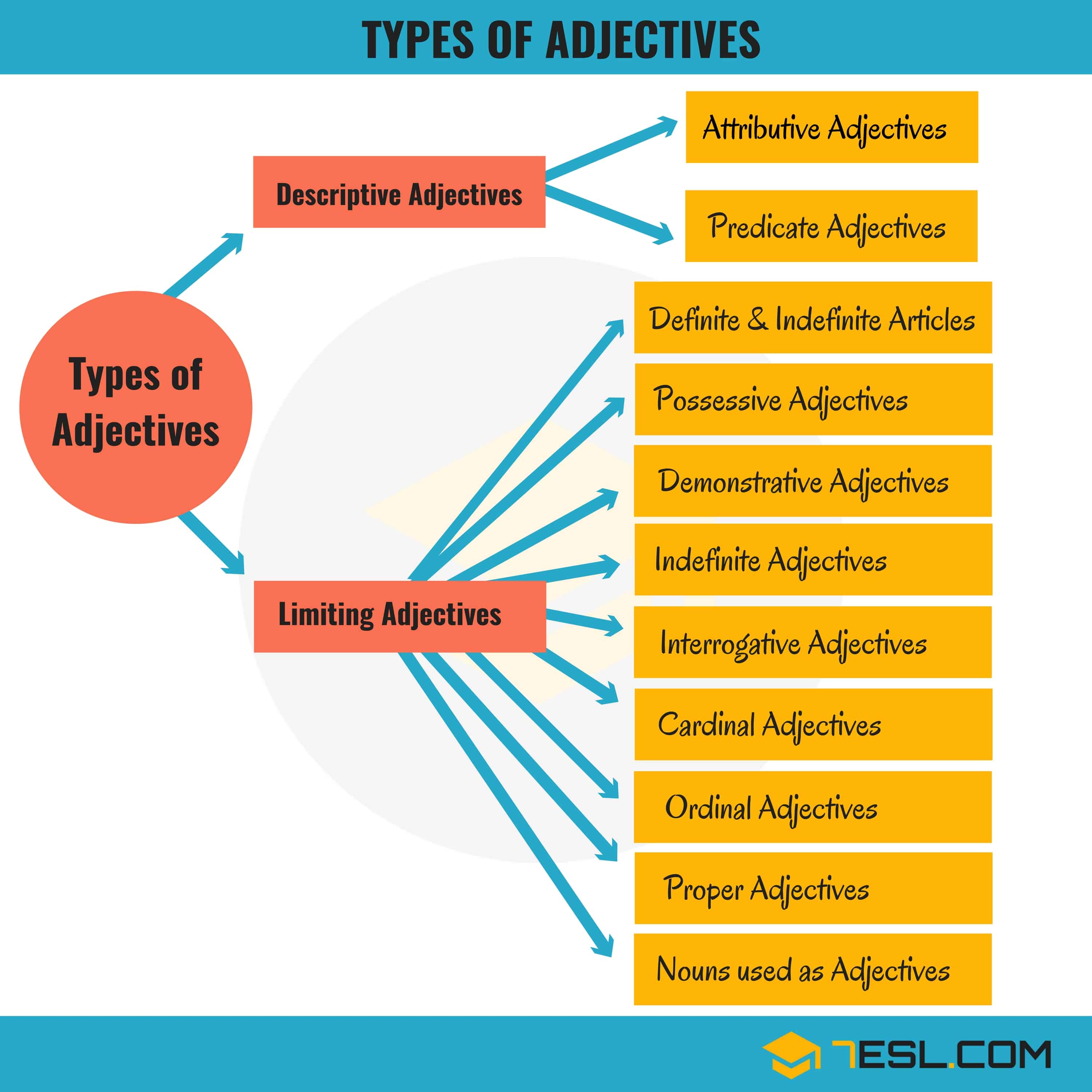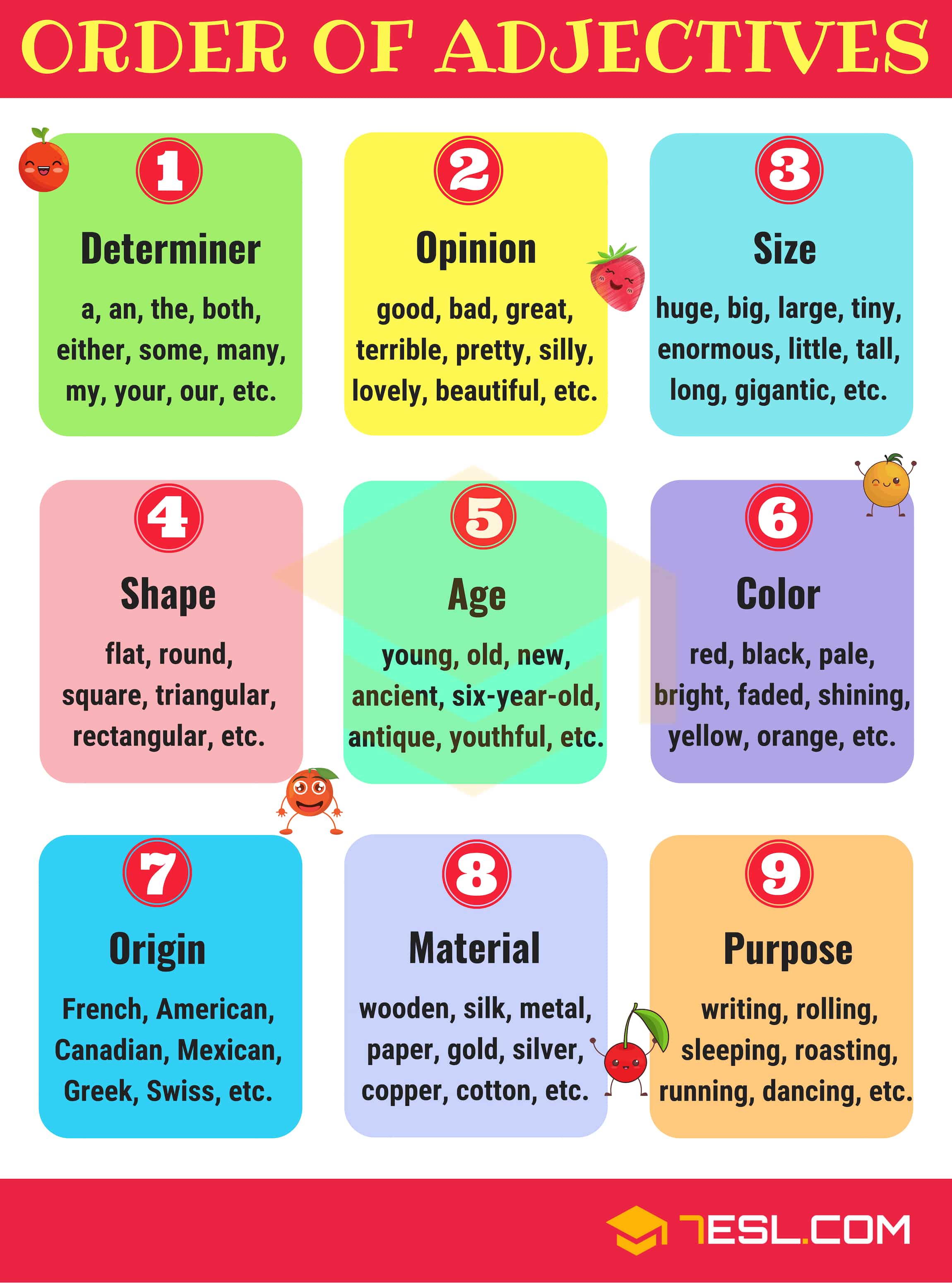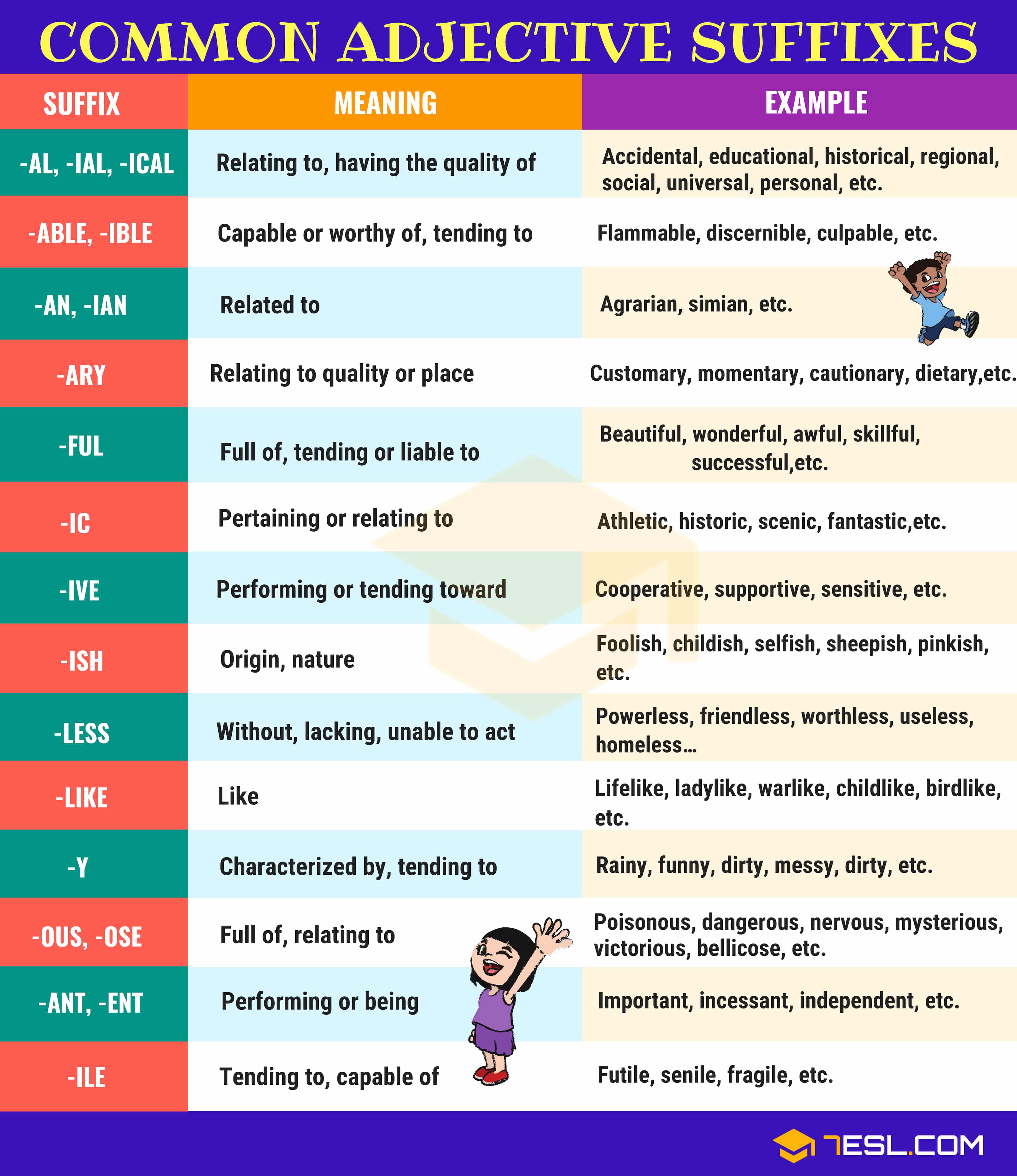What are adjectives? The adjective is an important part of a lot of sentences and is used in all languages, but what is their importance in the English language? In this article, we are going to be looking at what exactly an adjective is as well as how it functions within a sentence.
Adjectives can be used in many ways and help the speaker or writer to better describe something, giving the audience a clearer picture about what is being discussed. Adjectives can come in various forms and depending on their form and what type of word they are modifying, will depend on where they are placed within a sentence.
Adjective
What Is An Adjective?
Adjectives provide details about people, places, and things. We use adjectives to alter nouns and pronouns. For example, we can make a noun like duck more specific by introducing it with an adjective like tiny or quiet. While adjectives can make your writing more descriptive, it is crucial not to overuse them.
What is an adjective? In the most simple terms, an adjective is a word used to describe a noun. These words can add a more descriptive flavor to a sentence. For example, you might say something along the line of the following in order to describe a tree, “It is a tree.” If you were to add an adjective into the sentence, you would give a clearer picture of what you were trying to describe, by saying something such as “It is a large tree.” or “It is a large, leafy tree.” The words in bold are the adjectives and allow the listener to get a better understanding of the object being talked about.
How Important Are Adjectives?
An adjective can denote the color, size, condition, sense, quantity, appearance, time, or personality of a noun or pronoun. Also, adjectives are capable of expressing comparisons by degrees.
However, adjectives do not simply have to describe an object, they can also be used in order to describe something that is not tangible. A good example of this is the use of adjectives to talk about someone’s personality. You might say something along the lines of ” My father is an intelligent man.”
Adjectives are a great way to appeal to the senses by describing visual aspects, taste, smell, sound, and emotional or non physical attributes.
In short, adjective is a part of speech which is common that people use it almost automatically, both in speech and in writing.
What Is An Adjective? Adjective Definition with Examples
Questions Adjectives Ask
We can usually identify an adjective by asking specific questions like how many, what color, which one, or what type. The answers to the above questions help illuminate the adjectives present in the sentence.
Adjective Examples
English Adjectives can be identified by their endings. Common adjective endings are as follows:
- -able/-ible: credible, achievable, gullible, capable, illegible, sensible, remarkable, horrible
- -al: annual, functional, individual, logical, essential
- -ful: awful, cheerful, doubtful, faithful, forceful
- -ic: terrific, cubic, manic, rustic
- -ive: intensive, adaptive, attractive, dismissive, inventive, persuasive
- -less: doubtless, endless, fearless, helpless, homeless, breathless, careless, groundless, restless
- -ous: adventurous, famous, generous, courageous, dangerous, tremendous, fabulous
Though, a large number of adjectives are different…
- hot
- dark
- smart
- cool
- common
- complete
- large
- deep
- thin
- far
- attractive
- great
- doubtful
- cold
- crowded
- careless
- noisy
- quiet
- real
- pink
- silent
- simple
- strange
- generous
- wide
- young
- …
Do Not Overuse Adjectives
When writing you want to choose adjectives that enhance your writing. Select adjectives that give your writing purpose. While adjectives can add specificity to nouns, they can also weigh your text down if used indiscriminately. Avoid adding adjectives to make your writing pretty. Do not use adjectives to compensate for weak nouns. Instead, choose stronger nouns.
Gradable
We can grade most adjectives. That is to say, adjectives allow alterations of their meaning by adverbs. Examples of adverbs include extremely, slightly fairly, and very. When pairing gradable adjectives with adverbs we can adjust their intensity.
Example
- The ship was very big.
- She moved extremely slow.
Adjective or Adverb
Adjectives modify pronouns and nouns. In contrast, adverbs modify verbs. A lot of adverbs have an -ly suffix. Words like quickly and dangerously are examples of adverbs with this suffix.
Example
- Adjective: The girl is bad.
- Adverb: The girl moves badly in an office setting.
In the first example, the girl is being modified. In the second, the girl’s moves are being addressed.
Adjectives
Types of Adjectives in English
We are now going to look at the various different types of adjectives that can be used to spice up your sentences. There are two main types of adjectives as shown below.
Descriptive adjectives describe the quality of the noun. In fact, descriptive adjectives can be attributive adjectives or predicate adjectives.
Attributive adjectives appear before a noun in a sentence. In contrast, predicate adjectives tend to follow verbs. Become and look are examples of typical verbs in which adjectives follow.
While Limiting adjectives limit the noun being described. Each type of adjective helps to organize the almost limitless amount of adjectives. Where a particular adjective belongs depends on where we place it in a sentence.
There are different types of limiting adjectives as follows:
- Definite & Indefinite Articles
- Possessive Adjectives
- Demonstrative Adjectives
- Indefinite Adjectives
- Interrogative Adjectives
- Cardinal Adjectives
- Ordinal Adjectives
- Proper Adjectives
- Nouns used as Adjectives
Types of Adjectives – Imag
Listed below are some categories we use to sort the adjectives.
Descriptive
The most commonly thought of adjectives are descriptive. They help make our writing more clear and precise. Descriptive adjectives accomplish this task by modifying a pronoun or noun with an attribute. Hence, this type of adjective will come before a noun or pronoun.
Examples
- The blue dog saved the day.
- The horrid woman cursed at me.
- The smiling cat hid behind the couch.
Distributive
Distributive adjectives point to a particular noun. Usually, these adjectives appear before the noun they wish to modify. In addition, they tend to accompany singular nouns.
Any, each, every, neither, and either are examples of distributive adjectives.
Examples
- I do not want either jacket.
- I do not want any candy.
- Each choice is miserable.
Possessive
Possessive adjectives suggest ownership. Examples of possessive adjectives include the following: her, his, their, whose, your, its, our, and my.
Examples
- I liked his song.
- I love your jacket.
- I lost our money.
Interrogative
Adjectives that ask a question are interrogative. What, which, and whose are interrogative adjectives.
Examples
- Whose shoes did you take?
- Which dress will you wear?
- What dog did you adopt?
Indefinite
Not all adjectives make nouns more specific. Indefinite adjectives are non-specific. Examples of indefinite adjectives include no, few, any, several, and many.
Examples
- I saw several friends over the holiday season.
- I have few friends.
- I have no family.
Sequence
Sequence adjectives assign numbers to nouns; however, they do not demonstrate order with ordinal numbers.
Examples
- I enjoyed the first read.
- I was the second child.
- My third doctor made a difference.
Proper
Proper nouns birth proper adjectives. That is, proper adjectives forms from proper nouns. It is essential to capitalize these adjectives to stay true to the proper noun from which they arise.
Examples
- I have a German grandmother.
- She enjoyed Shakespearean plays.
- Canada is an English and French-speaking country.
Quantitative
Quantitative adjectives alter pronouns and nouns numerically. They answer questions of how much or how many.
Examples
- She wants three children.
- She keeps her four dogs in the house.
- I have two jackets from which to choose.
Adjectival Nouns
When a noun modifies another noun they become a functioning adjective. We call these transformed nouns adjectival nouns or noun modifiers.
Example
- Sports car
- strawberry salad
Alternatively, adjectives can masquerade as nouns. This occurs when groups of people are being described. The modified noun disappears and the adjective adopts the noun’s placement.
Example
- The young people would change to the young.
These adjectives always follow the.
Order of Adjectives
In general, the adjective order in English is:
- Determiner
- Observation (Opinion)
- Size and Shape
- Age
- Color
- Origin
- Material
- Qualifier (Purpose)
Adjective Placement
Where to Place an Adjective in a Sentence
Three types of placement adjectives exist. Attributive adjectives come before the noun they modify. A clear day is an example of this type.
Predicate adjectives, the second type of adjectives, follow a linking verb. These adjectives include seemed, are, am, is, was, were, and looked. “I was famished after dinner” is an example of this type of adjective.
Finally, postpositive adjectives follow immediately after a pronoun or noun. The phrase tickets available provides an example of a postpositive adjective.
The Position of Adjectives in a Sentence
To ensure that you have a properly formed and grammatically correct sentence, it is important to position the adjectives in the correct place. We are now going to take a look at where the adjective should be placed within a sentence in order to make it sound as authentic as possible.
An attribute adjective is placed before the noun it is modifying. Let’s take a look at some examples of this.
- She is a pretty girl.
- This is my green dress.
- Today, we will have heavy rain.
- Ants have tiny legs.
- It is a hot day.
You can also have a predicative adjective which is placed after the noun which it is modifying. Here are some examples to demonstrate this.
- This sandwich is tasty.
- The boy is tall.
- My cats eyes are yellow.
- The cake is not healthy.
- My daughter is beautiful.
There is also the opportunity to place an adjective after certain verbs in order to modify them. This does not apply to all verbs, so let’s take a look at some examples verbs which can be modified with an adjective. It is worth noting that when using an adjective to modify a verb, the verb should come before the adjective, it will not sound correct if placed the other way around. The following verbs can be modified with an adjective.
- appear
- become
- go
- get
- turn
- feel
- keep
Here are some examples of these verbs being modified with an adjective.
- I feel amazing after my spa day.
- He has become lazy having not had a job for weeks.
- The dog appears aggressive.
You can also use an adjective after the verbs to smell, to taste, to sound and to look. Let’s take a look at some examples of the adjective placement for these verbs.
- That pizza tastes fantastic.
- The music sounds good.
- It looks stunning.
- That smells awful.
Adjectives Without A Noun
It is possible to use an adjective as a standalone word without a noun. This can be seen in an example such as the following. “He is rich” the adjective here is being used with the pronoun he, however this can be used on its own as simply describing something as “rich.” You might also use an adjective on it’s own in a sentence such as the following, “The largest must go at the back.”
Adjectives In Pairs
You might wish to use more than one adjective in order to give you sentence a very descriptive feel. For example, you might say “This is a large, red car.” or “I am a clever, thoughtful person.”
Comparison of Adjectives
We can compare adjectives by degrees. Adjectives come in a three-degree hierarchy: positive, comparative, and superlative.
Positive
It is an ordinary form of adjectives. We use the positive degree when referencing a single person, thing, or place.
A positive adjective is used to describe something without making any sort of comparison to anything else. For example, as seen in the sentence “I am kind.” or “This is a great movie.”
Examples
- The boy is smart.
- The small girl likes cake.
- Loki knows that he’s tall.
Comparative
A comparative adjective is used in order to compare two things, it is quite often followed by the word than, you can see this in the following examples. “I am nicer than him.” or “This movie is better than the first one.”
When we describe two items or two individuals we use the comparative degree. Usually, we add the suffix -er to an adjective to produce this form. By adding -er to the word tall we get the comparative taller. If an adjective ends in y we must replace it with i before adding the suffix -er.
In addition, more placed in front of a descriptive word creates the comparative form.
Examples
- Fred’s party was more fun than Suzi’s.
- She is smarter than she thinks.
- Balto is taller than Merida.
Superlative
Indicates that the quality or quantity is at its highest or is most intense. A superlative adjective is used as a way of comparing more than two things and as a way to say that the thing you are talking about is the ‘most’, you might notice this in the following examples. “I am the nicest of all the students.” or “This is the best movie out of the entire series.”
We use the superlative degree when comparing three or more things. Adjectives in this form have the -est ending added to them. If an adjective ends in the letter y, it changes to i before adding the suffix. Like with the comparative degree, we can create the superlative degree by adding the word most.
Examples
- She is the smartest girl in the school.
- Robbi is the tallest when compared to his friends.
- She is more fun than the whole team combined.
Multipart Adjectives
We can use two adjectives to describe a noun. To make our writing flow nicely we use a coordinate and cumulative adjectives.
Coordinate Adjectives
Two adjectives of equal weight constitute coordinate adjectives. We separate them with a comma.
Example
- The girl had a vibrant, gorgeous smile.
Cumulative Adjectives
A cumulative adjective has two adjectives that build upon each other. There order only works one-way to create meaning. These adjectives cannot have the word and separate them.
Example
- The sickly sweet smile scared everyone.
Compound Adjectives
Compound adjectives in this category consist of at least two hyphenated words.
Example
She loved her six-foot snake.
List of Adjectives
You can literally use an adjective to describe a whole wealth of things from how something appears to what it smells like or its size. We are now going to look at a few examples of adjectives to describe different things.
Examples of Adjectives
Taste
- Delicious
- Bland
- Bitter
- Sweet
- Tasty
Touch
- Soft
- Windy
- Oily
- Smooth
- Cold
Sound
- Noisy
- Whispering
- Shrill
- Silent
- Hissing
Size
- Gigantic
- Huge
- Minute
- Tiny
- Wee
Shape
- Narrow
- Hollow
- Straight
- Rotund
- Crooked
Time
- Late
- Old
- Slow
- Speedy
- Daily
Amount
- Lots
- Many
- Ample
- Sparse
- Enough
Emotion
- Excited
- Amused
- Kind
- Grumpy
- Boring
Personality
- Generous
- Happy
- Smart
- Sassy
- Jaunty
Appearance
- Attractive
- Fat
- Spotless
- Confident
- Plain
Situation
- Nasty
- Aromatic
- Illegal
- Rainy
- Worse
Adjectives Ending in -ED and -ING
Learn the difference between adjectives ending in -ED and -ING with useful rules and examples.
List of adjectives ending in -ED and -ING
- Amazing – Amazed
- Amusing – Amused
- Annoying – Annoyed
- Boring – Bored
- Disgusting – Disgusted
- Disturbing – Disturbed
- Embarrassing – Embarrassed
- Entertaining – Entertained
- Exciting – Excited
- Fascinating – Fascinated
- Frightening – Frightened
- Frustrating – Frustrated
- Inspiring – Inspired
- Interesting – Interested
- Pleasing – Pleased
- Relaxing – Relaxed
- Surprising – Surprised
- Terrifying – Terrified
- Threatening – Threatened
- Thrilling – Thrilled
- Worrying – Worried
Adjective Suffixes
Common adjective suffixes in English
- -al, -ial, -ical
- -able, -ible
- -an, -ian
- -ary
- -full
- -ic
- -ive
- -ish
- -less
- -like
- -y
- -ous, -ose
- -ant, -ent
- -ile

















0 Comments